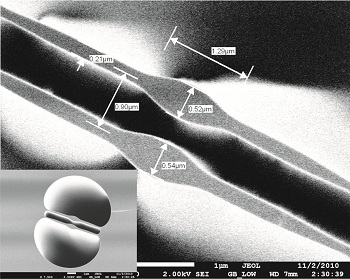
Cross-section and extreme magnification of the nanomechanical fiber. (Center)The dual cores are 0.5 micrometers across at their centers. The supporting glass filament is 0.2 micrometers across. The small-scale structure was achieved by heating and drawing out a larger fiber-optic form. Credit: Optics Express.
Once drawn, optical fibers are usually mechanically rigid—frozen forever. But scientists in the United Kingdom have used tiny mechanical interior movements to switch light between the two cores of a single glass fiber (Opt. Express 20, 29386). The experiments could lead to “smart fibers” for many telecommunications and sensing applications.
Research associate Zhenggang Lian and his colleagues at the University of Southampton’s Optoelectronics Research Centre constructed the nanomechanical fiber out of lead silicate glass, with the two cores independently suspended and yet optically coupled.
The team fabricated the dual-core fiber on a standard draw tower, using a slow extrusion speed and relatively low furnace temperature to avoid distortion between the closely spaced cores. At one point along the fiber, the researchers etched away the cladding to provide the outside environment with access to one of the cores.
The altered section of fiber was passed through a nitrogen-filled pressure chamber, which the team used to apply selective pressure on one of the cores. The researchers beamed polarized diode-laser light at a standard telecommunications wavelength (1,550 nm) down the fiber. By varying the chamber pressure by a few hundred millibars, the team moved one core by as much as 8 nm and switched the light between the two cores.
In future applications, the researchers suggest, electrostatic actuators, now used in many micro-electro-mechanical systems (MEMS), could perform the tiny mechanical movements more quickly than the external pressure changes. Such nanoscale devices within fibers could move some of the switching, buffering and routing functions of a network from optoelectronic chips to the fibers themselves. Sensors could benefit from the ability of the fibers to detect minuscule pressure changes or vibrations in the environment.
